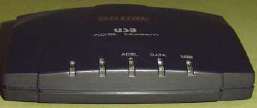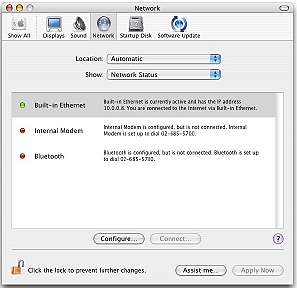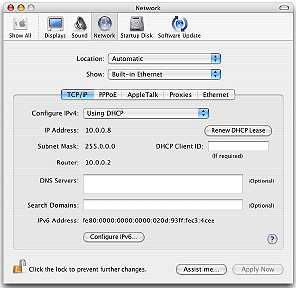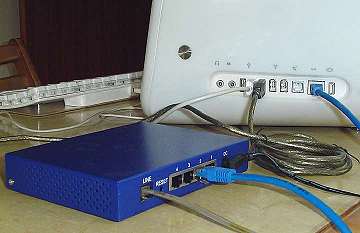
|

|

|

|
eXtensions
|
Mac, Ethernet and ADSL: They Said it Would not Work |
Revised: 15 December 2004
When TA (as it was then) offered ADSL last year, I thought it was time to upgrade, but when I mentioned the "Mac" word, adding that I would use TCP/IP and not a USB modem, the man entering the data went pale. After trying to convince him that it would work, I left the form unsigned.
Recent months have seen a greater uptake of the service and I decided that, despite being spoiled by an office network, I wanted to play at home too.
I had communicated with Wisrute Buddhari, of Alfa Club Thailand, who uses such links, and an Airport network, at home, all defying the Mac naysayers. Along with some technical advice, he suggested I should accept the USB modem graciously and not mention the Mac.
The application went smoothly at the Central Pinklao branch of TRUE and a couple of days later, a sweet lady phoned. I collected the USB modem the next afternoon and paid the fees.
I had already bought a PCi modem/router at Phantip Plaza. The modem/router links to the computer via the Ethernet port (with TCP/IP no drivers are required) thus setting up is easier. Even without ADSL, once it is powered up a user can access configuration procedures -- installed in the modem itself -- using a browser. An advantage (for me) of this device is that it has four Ethernet ports: fine for a small network.

|

|

|

|
The TRUE staff at Pinklao were helpful; but TRUE does not really recognise Mac users. Apple still holds a small share of the market and for most companies Macs do not exist. When a friend went into the TRUE shop the previous day, however, she had been informed that the USB modem would work with her PowerBook (although no drivers are provided). This contradicts what I had been told. However, there is a grain of truth in both versions.
The USB modem is made in China, but the company, Billion, is based in Australia and its website has drivers for OSX, OS9 and for Linux.
I downloaded the Mac drivers and an extensive PDF Mac/Linux manual. I installed the driver as an experiment. Unlike normal modem drivers it does not appear in the modem list because it emulates Ethernet: we pretend we are using a network.
I have a gripe about this situation. Billion provide the drivers and documentation for Linux, OSX, OS9 and Windows online; while TRUE seems to deny the existence of the first three. As I was writing this column, one of my former students (now an eMac user) pointed me in the direction of a discussion (in Thai) of the USB modem, on the Thai discussion board, Freemac.net. It would not be difficult, if a Mac user did want to use the USB device, for TRUE to have a couple of CDROMs at their premises: even the TRUE website only has the Windows driver.
I was promised installation at noon on Friday. I was ready early and so were the True team: they were outside at 0915. The visit (with a small charge for connecting to my upstairs office from the box downstairs) took about 20 minutes.

|

|
The team -- quiet and polite -- had the telephone working in 15 minutes and said that the Internet would be up in about 2 hours. They had never seen the modem router I was using, but accepted the fact. They confirmed that the TCP/IP settings should be DHCP, not manual: the system gives the settings automatically.
 Getting a connection was not quite as clear cut as I had hoped. Some
playing about (and a phone call) soon had things running. In a local
area network (LAN), the Network Preferences settings are for the
network router. They are not taken from the TRUE server.
Getting a connection was not quite as clear cut as I had hoped. Some
playing about (and a phone call) soon had things running. In a local
area network (LAN), the Network Preferences settings are for the
network router. They are not taken from the TRUE server.
With ADSL, the Preferences panel shows settings from the modem because that is the router the computer connects to. The TRUE IP settings are shown in the browser configuration. One default setting was wrong on the "WAN Configuration" page.
Suwannee, from TRUE's helpdesk focussed immediately on the problem area. The USB modem has local settings installed as default. Those who access using a router will not have the right information and must ask.
I had correctly entered the username and password, but at the top of the configuration page was a box for VPI (virtual path identifier) and VCI (virtual channel identifier). The default for VPI (zero) was correct, but VCI had to be changed to 100 from 35. The moment the router was reset, an IP number appeared on the page. With no additional drivers, I started faster Internet work in minutes, including the software downloads I had anticipated.
Mac users delaying connections, should not listen to the pundits: ADSL plus a modem/router is fine.
Note: I can confirm that the Billion router does work with the drivers downloaded from the Billion site. According to a colleague who did this with his PowerBook, the trick was (again) entering the correct VCI number into the configuration panel.
Note 2: A colleague with a 15" powerook contacted me and pointed out that the TRUE office he used gave the option of a Billion ADSL modem/router -- with four Ethernet ports -- for an additional 3690 baht (about the same as what I paid for the PCi router). One difference is that it is already set up for the TRUE service and all that is needed are the username and password.
It was also pointed out that, sometimes there are difficulties for OSX users. The BSD Unix subsystem may have difficulties with ADSL. The cure may be to enter information for DNS servers in the panel found in Network Preferences (see above). For TRUE, the DNS servers are 203.144.255.71 and 203.144.255.72. Both should be used: one line for each.
Why doesn't TRUE provide this information more openly?

For further information, e-mail to Graham K. Rogers.
Back to
eXtensions
To
eXtensions: Book Reviews
To
eXtensions: Year One
To
eXtensions: Year Two
Back to homepage